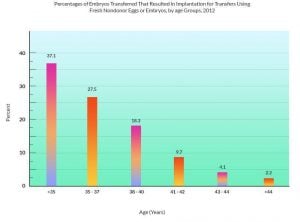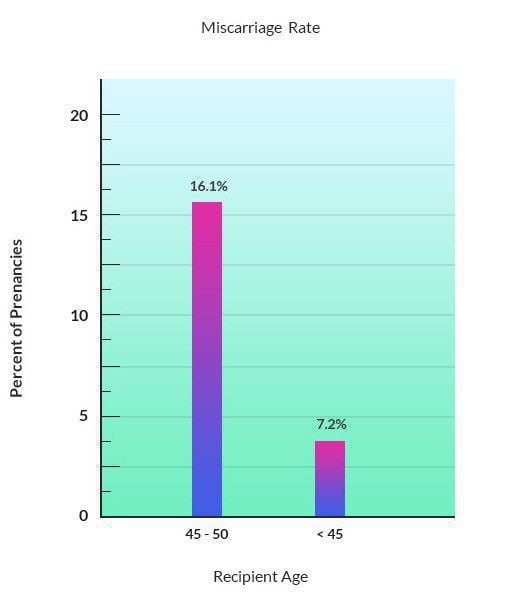
Effect of Recipient Age on Outcome in Egg Donation
Research presentation by Dr. Richard Sherbahn at the Annual Meeting of the American Society for Reproductive Medicine, San Francisco, CA, November 2008.
Introduction
There has been some controversy regarding the issue of whether uterine receptivity declines with advancing age. Paulson et al. (1) found no age-related decline in endometrial receptivity. However, Yaron et al. (2) found a lower pregnancy rate and a higher miscarriage rate in older recipients.
This study was undertaken in order to investigate further whether there were differences in outcome parameters of egg donation cycles as a function of the age of the female recipient.
Materials and Methods
All egg donation cycles (452 cycles) using a donor under 31 years of age and having an embryo transfer to a single recipient over a period of 10 years (1998 - 2007) were retrospectively analyzed
Recipients were separated into 2 groups according to age, with women under 45 in one group (364 transfers) and women 45-50 in the other group (88 transfers)
Data for each group was analyzed and compared for recipient age, donor age, number of embryos transferred, implantation rate, clinical pregnancy rate, miscarriage rate, and live birth rate
Statistical analysis was performed by the t-test, chi-square analysis or Fishers exact test where appropriate.
Results
- There were no differences in the mean donor ages or the mean number of embryos transferred between the 2 groups
- Recipients 45-50 years old had lower implantation rates, clinical pregnancy rates, and live birth rates as well as a higher miscarriage rate as compared to women under 45
- The differences between the recipient age groups for both implantation rates and miscarriage rates was statistically significant (see table below)
- The differences between the recipient age groups for the clinical pregnancy rates and live birth rates did not reach significance
| Egg Donation Outcome According to Recipient Age | |||
|---|---|---|---|
| Means +/- SD | Recipient Age < 45 | Recipient Age 45-50 | P value |
| Recipient Age | 37.9 +/- 4.6 | 46.6 +/- 1.6 | P < 0.0001 |
| Donor Age | 23.8 +/- 3.4 | 23.1 +/- 2.9 | NS |
| Number of Embryos Transferred | 2.2 +/- 0.5 | 2.3 +/- 0.6 | NS |
| Clinical Pregnancy Rate Per Transfer | 251/364 - 69.0% | 56/88 - 63.6% | NS |
| Miscarriage Rate | 18/251 - 7.2% | 9/56 - 16.1% | P <0.05 |
| Implantation Rate | 373/795 - 46.9% | 71/201 - 35.3% | P = 0.004 |
| Live Birth Rate Per Transfer | 233/364 - 64.0% | 47/88 - 53.4% | P = 0.07 |
Implantation Rate by Recipient Age
Miscarriage Rate by Recipient Age
Summary
- There is a significant reduction in implantation rates in egg donor recipients 45-50 years of age
- There is a significant increase in miscarriage rates in egg donor recipients 45-50 years of age
Discussion
- Uterine receptivity might decline with advanced age due to unknown biochemical and/or molecular aberrations of the endometrium
- This decline could also be the result of a higher incidence of other pathological conditions in the uterus such as myomas, synechiae or polyps
- Hypertension and other systemic disorders are more common in older women and could be contributing to the reduced potential for implantation and successful pregnancy outcome
References
- Paulson et al. (1997) Cumulative conception and live birth rates after oocyte donation: implications regarding endometrial receptivity. Hum. Reprod., 12, 835-839.
- Yaron et al. (1998) Oocyte donation in Israel: a study of 1001 initiated treatment cycles. Hum. Reprod., 13, 1819-1824.
Categories
About the AFCC Blog
Welcome to the Advanced Fertility Center of Chicago’s blog! Here, you will find information on the latest advancements in fertility care and treatments, including IVF, IUI, third-party reproduction, LGBTQ+ family building, preimplantation genetic testing, and more. Since 1997, we’ve used our experience and continuous investment in the latest fertility technology to help thousands of patients grow their families. Contact us today for more information or to schedule a new patient appointment.



